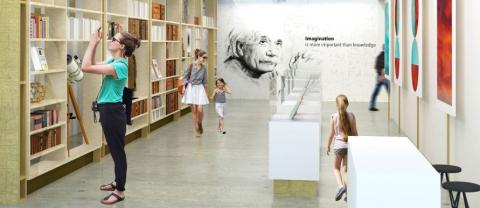Albert Einstein Museum to Open in Jerusalem
The university, together with the Peres Center for Peace, has been trying to advance the construction of the Einstein Museum for a long time. The firm of British architect Norman Foster, which designed the recently inaugurated Center for Brain Sciences on the Givat Ram campus, had submitted a proposal for the building for the Mount Scopus campus, at a cost of about $20 million.
The names of American Jewish architects Frank Gehry and Daniel Libeskind also came up in this context, and they even met with the late President Shimon Peres, the guiding spirit behind the initiative. The project faded away around the time that Peres’ term ended due to lack of budget, but Hebrew University’s desire to build a museum for Einstein and a place for his archive didn’t.
According to university CEO Billy Shapira, the institution looked for a location that would allow for low construction costs and decided that the planetarium building could meet this requirement. Shapira notes that the location was also chosen because it will be accessible by the new light rail line planned for the area and for its proximity to other institutions – it will be part of Jerusalem’s Museum Row. The cost of building the museum will be $5 million and a search for donors will soon begin.
The university held a competition for designing the museum and Shapira finally chose Arad Simon out of four Jerusalem architecture firms. She says that the winning proposal was “modest, not grandiose, and it spoke to us.” Architect Salma Milson Arad explained that her firm has decided to excavate beneath the existing 500-square-meter old building. “Although the historic building has not been designated for strict preservation, it’s modest and blends into the campus, and therefore we decided not to build above it or next to it, but rather to dig beneath it,” she tells Haaretz. “The significant change in the façades will be opening a window in the eastern façade, which will offer a view in the direction of the Old City and the Knesset, an element that expresses Einstein’s connection to Jerusalem.” Next to the eastern window will be a space for studying and reading.
The original building is composed of a rectangular space and a dome. The new design includes a separation between the visitors center, which will be located inside the dome, and the archive and research area, which will be situated in the rectangular part. The entrance lobby, which will host temporary exhibitions, will be shared by the visitors, the archives staff and the researchers. Next to the lobby will be the souvenir shop and an administrative office. Einstein’s historic library will be placed in the lobby, which is designed as a semi-transparent “wall” of books that separates the visitors from the archives and the research wing. The wall will accompany visitors from the main entrance to the visitors center in the planetarium building to the west.
Stairs will lead from the research area to the visitors center, where, as the designers put it, there will be a “reversal of situations”: The upper dome will be dark and will be used for displays of Einstein’s studies, while natural light will illuminate from above, through 12 “wells” of light that surround the dome. “The wells of light will display the movement of the sun in the sky during the day and throughout the days of the year, and will present a different show at every moment in the visitors center,” says Milson Arad, explaining how it will illustrate “the meaning of the concept of time, which Einstein was engaged in.”
The excavated floor will be designed as a bowl, enabling visitors to lie down and observe the ceiling of the planetarium, which will show information and milestones from Einstein’s life. The rectangular part of that floor will house the protected archives, the meeting room, the preservation and photography room and the conference hall.
Naama Riba

